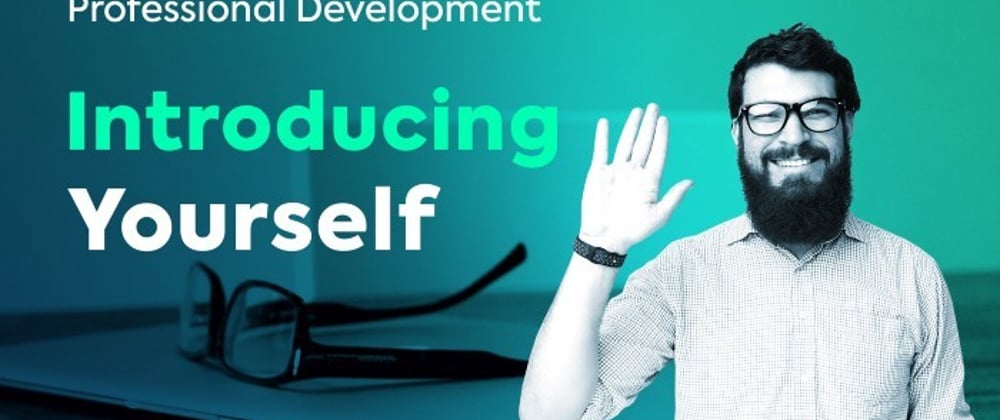There you are, hovering your cursor on the link that’s about to drop you into your first call with the new team. It’s your first day at work on a new project, you don’t really know anyone yet, and you’ll need to say hello and introduce yourself.
Gulp.
If you can feel an onset of anxiety at that thought already, rest assured you’re not alone. An arguably healthy wariness of strangers is built into our genes, and we all get to experience it as children. Still, that fear will stay with many of us well into our adulthood as well. Studies have shown that being around strangers raises our levels of cortisol, a hormone that produces stress responses and makes us less empathetic. Your brain is identifying this as a “stranger danger” situation, and it responds by trying to minimize the exposure of your thoughts and vulnerabilities in the face of potentially threatening outside influences.
But you’re telling your brain to do just the opposite.
When introducing yourself, you aim to convey an exhaustive, confident and purposeful story about who you are — not only what you’ve done, but also why you did it, what intimate belief system is driving your actions, what your strengths and weaknesses are, where you plan to go and how you’re working towards getting there. Plus, you’d like to impress your teammates and be memorable.
The fact that you prepared well ahead of tapping that link will make all the difference.
Accept the anxiety.
It does happen to everyone. Remind yourself how great you’ll feel after and how proud you’ll be of the progress you’ve made. Studies also show that, although people are often reluctant to have a genuine social interaction with a stranger, they are happier after a situation where they treat a stranger as a friend. This fact holds for introverts and extroverts alike. Hack this and set up for success by visualizing yourself feeling confident and speaking to an attentive and warm audience of like-minded humans.
Tell a proper story.
Spend time to properly polish the short story of you. It’s concise, but it’s a proper story, so give it a story arc. It should have a relatable setup, some conflict and resolution, and a sweet ending that leaves the audience wanting more.
Act one: Where we set the scene & introduce the hero.
Why do you care?
A good setup should quickly establish our hero’s origins and affinities and create an authentic frame that will support the rest of the story:
Think back to your past, all the way to your childhood. Who were your heroes?
What did you enjoy doing? What were your passions, talents, and interests?
When did you first think: “I’m going to be a software developer”?
Is there any moment in your past you would like to relive?
What turning points in your life stand out?
What are your strengths?
Think about the problems that only you can solve.
On what do teachers, teammates, or friends usually compliment you?
Remember that we tend to underestimate or minimize our strengths. The Reflected Best-Self Exercise (Roberts et al., 2005), created at the University of Michigan, helps you mitigate this. In essence, you ask 15–20 people close to you to write stories about you at your best, then analyze the feedback for strengths, weaknesses, enablers, and blockers. More on that here.
Act two: Where our hero grows and changes in response to conflicts and circumstances.
What did you do?
This is where, driven by ambition and passion, the hero sets about trying to resolve some big problems, encounters all sorts of adversity that he manages to overcome, and learns some valuable lessons.
Recall the significant professional choices you have made (majors, internships, certifications)?
Why did you make those choices? How did they play into your bigger plan?
What languages and what technologies have you been close to over the years?
What are the biggest challenges you’ve overcome in developing your coding craft?
What sort of projects have you completed? Communication or financial apps, ad-hoc plugins, e-commerce platforms? What’s your specialty? What industries do you know?
Think hard about your accomplishments. What effort made you most proud of yourself? Something that few of your peers have achieved in their work?
What praises did you get?
Don’t recite your job history, unless the names of the companies in your past are internationally recognized and appreciated. Instead, focus on the industries you’ve developed solutions for, the skills you’ve mastered, and the most formidable obstacles you’ve knocked down.
What valuable insights/strengths/skills have you gained along the way? What loot has our hero picked up?
Act three: Where we deliver a satisfying conclusion and tease the sequel.
Where are you going?
You should paint a happy end, where the hero has proven his worth against the world and is ready to take on even more significant challenges in the future:
How are you currently growing?
What are the state-of-art technology toys that get you excited?
Whom will you battle next? What challenges still lie ahead, and how will you overcome them?
What’s your next adventure? What are your dreams and aspirations? What sort of projects would you like to pursue?
What’s your longer-term plan?
Now tailor it to your audience.
You should be ready to deliver at least three versions of your introduction story:
The extended version (3m — 5m). Cram everything that’s worth mentioning in this one; go into a little detail, and add some personal color. You can use this to answer the infamous “tell me about yourself” interview question.
The standard cut (1m). You get this version by trimming down the extended one. While less lengthy, it should still be elaborate, showcasing your journey and touching on all facets of your experience, while lingering a bit more on the things most relevant to your audience. This is an excellent choice for many situations, including your team intro.
The elevator pitch (30s). The most focused version, where you want to cherry-pick the aspects of your experience that your audience will want to hear and will find most relevant and impressive. You can also use this for your team intro, or as the “about me” description for your GitHub profile.
Show a little vulnerability.
It turns out that vulnerability allows for deeper connections to take root between humans:
“One key pattern associated with the development of a close relationship among peers is sustained, escalating, reciprocal, personalistic self-disclosure.”
(Aron, Arthur, et al. “The experimental generation of interpersonal closeness: A procedure and some preliminary findings.”)
Don’t shy away from speaking about the things you’ve struggled with or are still struggling with, professionally or personally. Show that you’re aware of issues and on top of the situation. You can even have a quick laugh at your own expense. Then switch right back into your hero story.
Practice.
You’ll most likely need more than twenty dry runs to nail it. Practice by yourself a lot, but do it in front of some friends as well, and gather feedback. If you’re anxious, remember to speak a bit louder than you usually do. Keep a quick but easy-to-follow pace, don’t rush. Record yourself, and play it back. Also, remember that every presentation doesn’t need to be perfect — next time, you’ll get even better at this.
Get inspired.
If you get a little creative with Google, you can find many pages full of examples of software engineers introducing themselves in real life. Here’s a good start:
I’m Nicholas, but people call me “Nas.” I’m a frontend developer, and I specialize in efficient React apps and CSS & HTML that just work across all platforms and browsers. I care deeply about building interfaces that are usable and pleasant for the most number of people possible.
My professional life has been 100% driven by my passion for design and structure. I was sketching crazy detailed 3d models for fun when I was a kid, started building promo websites for small businesses while in school, then developed an app for my gaming guild in my university days. For three years, I’ve worked for an e-commerce platform in Berlin, where I was able to drive a 10% growth in sales by shaving five seconds from the website’s loading time. After that, I was in charge of implementing and launching the mobile app for a large European medical supply provider, which I was able to complete in just under three months. Not that learning React Native at the same time made things easy for me. Still, in the end, I was able to deliver an app that’s used by hundreds of distributors and direct customers daily and did so on-time and on-budget.
Right now, I’m excited about the still very complicated WebAssembly, and working towards becoming a React senior. In the following years, I also plan to explore the “server-side” more and become a better-rounded full-stack dev.
Continuously tweak it.
You’re always changing, and so should your introduction. Keep incorporating your new and exciting experiences. Note what reactions you’re getting from your audience throughout your pitch, adjust accordingly, and keep experimenting. Think about how you’d like your intro to sound a year or two from now. Maybe you see yourself saying you’ve become an open-source contributor, or that you’ve mastered NumPy at last. Whatever it is, work to make it real. It’s the story of you, after all.
Telepat North is a club for outstanding coders, offering members free books, courses, learning resources, swag, and remote work opportunities!
If you’re interested, you can learn more by visiting Telepat North.
If you enjoyed this article, press the “Follow” button to get more content that will help you become a better technology professional. You can also subscribe to our YouTube channel, and follow us on Facebook, and LinkedIn.







Oldest comments (0)